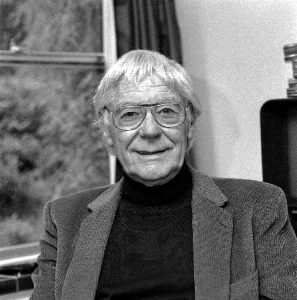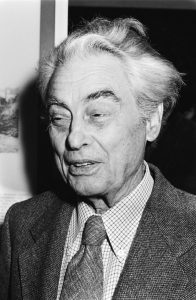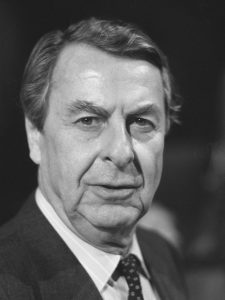From the very beginning of the “chemical era” of the filmindustry, almost nothing has been preserved. But after that beginning there were the three “big” names:
Joris Ivens (filmed from 1912 to 1988)
He shows the beginning of the Dutch film. There was almost no Dutch film industry. On the list of his films is therefore mentioned in which country the recordings are combined into a full movie. His work shows him as a bright socialist born between the Calvinists in the north of the Netherlands and the “rich Roman life” in the Southern part of the country.
 Bert Haanstra (filmed from 1949 to 1988)
Bert Haanstra (filmed from 1949 to 1988)
Represents the highlights of Dutch cinema. His films show the cozy Calvinist of the northern Netherlands who (after 1945) again looked for the relaxed smile, the harmony.
Fons Rademakers (filmed from 1958 to 1989)
Can be seen as a representative of the “rich Catholic life” (in the southern Dutch provinces) by his films. In his movies, modern times (Anglo-American influence) looked “around the corner”.
Dutch Cinema
With the first films also cinemas came in the Netherlands. Those cinemas developed into cineacs. The programming was (schematical) as follows: a few short current news items followed by the background to the news and some longer reports of the (planned) events (royal visit, states-general, and sports reports). Initially the programming was very short and concise. The slogan was “the world in 60 minutes”. (Over time, the cycle grew longer). After a cyclus, the program restarted, and so forth. The visitors bought a ticket and stayed there until they had enough of it. This continued throughout the day. With the advent of the sound and later the color films, a visit to the cineac became a popular getaway for families.
This was the time when cineasts like Joris Ivens and (later) Bert Haanstra became very famous. There are three of these cineasts (finally Fons Rademakers also joined them) that laid the foundation for the Dutch film industry. Therefore, attention has been paid to them. To appreciate their contribution there follows a (very brief) overview of the social developments in their time.
Post-war times
The Anglo-American influence.
 At the end of 1947, before the start of the Marshall plan, the British, French and Dutch production was already at the pre-war level. Italy and Belgium followed the end of 1948. But that was achieved in deep poverty and long working days. Furthermore, the possibilities of rebuilding those heavily destroyed countries were very limited and so proceeded slowly until the Marchall plan came about.
At the end of 1947, before the start of the Marshall plan, the British, French and Dutch production was already at the pre-war level. Italy and Belgium followed the end of 1948. But that was achieved in deep poverty and long working days. Furthermore, the possibilities of rebuilding those heavily destroyed countries were very limited and so proceeded slowly until the Marchall plan came about.
On April 26, the ship Noordam arrived with the first goods of the Marchall assistance. Many Dutch had tears in their eyes (in their cineac’s) when watching her arrival. That aid (1948 – 1952) consisted for 80% of goods (food and machinery) and for 20% of credits. Officially it was called the Europian Recovery Program (ERP) utility. George C. Marchall was the US minister of foreign affairs who did it. So he received the Nobel Peace Prize in 1953.
New times
This period of major differences in public opinion is often referred to as flowerpower (or as the fame of the 1960s). Important events were the Cuba Crises (October 1962) and Prague Spring (1968) but the highlight was the major demonstration against the nuclear missiles (October 29, 1983) when more than half a million Dutchmen demonstrated along the Binnenhof. The prime minister, Ruud Lubbers, received about 3.7 million letters (undersigned!) against those same missiles two years later (26 October 1985).
This period lasted until about 1989 when the Poles pulled that first stone from the iron curtain (wall) between eastern and western Europe. (See also: Back in Europe, Part 3).
Modern times
This era begins (symbolic) with the fall of the wall in 1989. The changes in Europe then brought a reinterpretation of the visions (Liberals, Calvinists and Catholics). Also most Dutch households had a color TV and (digital) photo and digital movie equipment (the filmcassette). In a gradual development process, the film industry also changed. One might argue that that change (which began with A Space Odyssey, 1968) was ripened in 1989. Making movies had become a real American “high-tech” industry (Hollywood).
An era was closed. The three “big filmists” are no longer active in this modern time. But of course, young filmers have also risen in time, and they also started to make movies. A few of them are listed in Modern times. The future will teach us who will become the “big ones” in this DVD era.
Cartoon films
Under contruction
Han Tiggelaar


